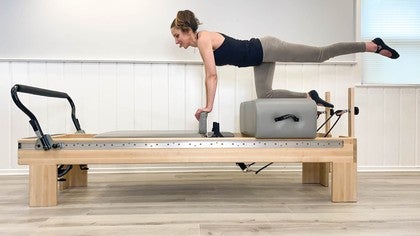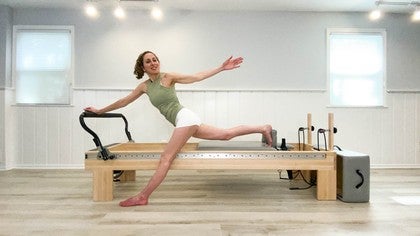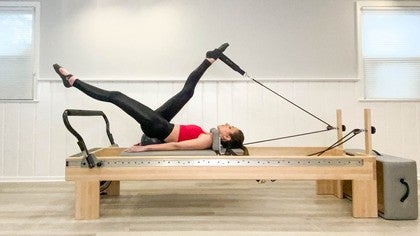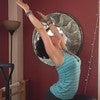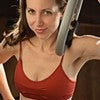Description
About This Video
Transcript
Read Full Transcript
So welcome back to Pilates-ish on the reformer. Today, we're going to do pulling exercises and we're actually gonna start basically using the reformer as if it was sort of like a rowing machine. I'm gonna need my foot bar a little bit lower than this, just so that I can sit on the frame and then I'm going to just go ahead and let the carriage kind of float away so that I can step in. And then I'm gonna pull the carriage back towards me and then I'll put a blue spring on, but I wanna make sure I could reach the straps as well. So I'm just gonna grab a hold of the straps and then I'm going to make sure they're reasonably loose and I'm going to attach a blue spring.
You could do a red spring, you could do a yellow spring. You're probably gonna need some kind of a spring. So I'm gonna start standing all the way upright, trying to make sure that my weight is evenly distributed between my left foot and my right foot and it's a little bit crowded in here, 'cause there's springs and different things, but I'm just gonna start with a standing row and then let my arms extend. So right now I'm not trying to protract my shoulder blades before I start, sometimes I do when I row, but I'm just trying to have my shoulder blades kind of set on my back. Pull my elbows towards my side.
And extend, and I might have to lean back a little bit just because I'm trying to counterbalance the weight of what I'm pulling. I'm gonna pull back and extend, a couple more like this. Pull back and extend. Pull and extend. I'm gonna turn my hands and my thumbs are up, I'm gonna turn my hands so that my thumbs are facing each other.
I'm gonna pull wider, but not like wide and high, because that really gets into upper traps and I don't know about you, but I like to work my upper traps all day long by like having stress and carrying it in my shoulders. So I want to go a little bit lower so that I don't create unnecessary stress or extra stress. I don't know that any of my stress is really necessary. Pull and back. Now, I wanna make sure that if I have a seat, there's something for me to sit on.
So I'm just gonna sit down, make sure I feel like my squat position is sort of a comfortable position. I'm gonna lean forward a little bit, pull in and stand up. As my arms extend, I do a little bit of a hip hinge and then sit back down. So it's kind of a game too, playing try not to let the carriage hit you. So I'll stand up.
Pull and then try to sit down. Find that sweet spot where it doesn't hit my legs. Stand up, pull, begin to lower down. Let my arms extent. I'm gonna go a little bit wider with my rows.
Stand up, pull, lower down, my arms aren't going all the way straight, because then if I went all the way straight right away, it would hit my knees and I'm trying to keep it a little bit away from me. I think on this one, I might be able to go all the way straight. That was not as graceful as one might hope. I'll do two more. And last one.
And then I'm gonna stand all the way up. Now, this one, I don't expect a huge movement from me. You might get a little bit more of one, but I'd wanna do a little bit of like a standing forward fold with a little bit of an arm press, not behind me, but just down and back a little bit. So standing up, shoulders down, chin towards your throat, begin to round forward, slight press. You should feel your abs kind of kick in and then lift yourself all the way back up.
Again, chin towards your throat. So we round forward and lift back up. Let's do three more like that. Round forward one. And up.
Round forward two. And up. And round forward three and then come all the way up. So I know this is gonna hit my legs and I'm just gonna kind of have to be okay with that. I'm just gonna go ahead and let the straps lower down.
I'm gonna scoot back a smidge, just to take the spring off, because it's not very comfortable. Knowing that you don't have any springs, just be really careful having a seat on the carriage and I'm just gonna lift my foot bar up to its normal kind of operating height and then I'm going to let the carriage come in and I'm gonna throw on a couple of red springs. Headrest is down. We're gonna start with a little bit of footwork, but it's really gonna go into bridging really pretty quickly and we're gonna do some arm work at this weight. So just find a weight that you can happily work with for at least a little bit of time.
So from here, go ahead and lie down on your back and we're gonna start, let's start on your tip toes and then we're gonna just push the carriage out. Now, because we're thinking about pulling instead of pushing, what I want you to do and this is a James D'Silva Garuda thing and I really think it's cool, is try to bend your knees without moving the carriage, then you get to move the carriage to come all the way in. So you push your legs all the way straight, bend your knees, but don't move the carriage, then when you can't not move the carriage, is when you get to move the carriage. Push out. Bend without moving the carriage.
Then you move the carriage. Push out. Bend and come in. Push out, bend and come in, let's do four more like this. Push out.
Bend and come in. Two, So it's a pull in, really more than it's a push out. I mean, still push out, but that's not our verb today, our verb today is pull. And then come in. We're gonna do just the slightest rotation of your legs, so your knees go out a little bit so that your heels can come together and we'll do the same thing here.
So you bend a little bit and come in. Push out, bend a little bit and come in. Little bend and in. Out, a little bend and in, out. A little bend and in, couple more times, out and in, last one, out and in.
You're gonna bring your feet just so they're in a relatively comfortable position. I kind of like, not really on my heels, kind of between my like sort of the arch of my feet. So from here, I'm gonna press out. We're gonna curl to come in. So it's going to be a pelvic curl and a lift.
So begin to bend your knees as you lift your hips up and then as you push out, you get to lower everything back down, pull in, lift up and lower back down. And also try to find that sweet spot where you don't feel like you're crashing the carriage. Lift up and back down. Lift up and back down, we'll do three more. Lift up and back down.
Lift up and back down. And we'll do one more like this, lift up and back down. Now the bad news is, we're gonna do a single leg version of this. So other leg, it can do whatever. You can hug it into your chest, maybe I'll do that.
You could hold on and just kind of leave your leg kind of where it is, might be a little bit easier to have your hands by your side. It's the same deal. You're gonna curl, lift in and then push out, lower down. So let's do four of this. Two, try to keep your hips level and down.
Three and down and four and down. Left foot comes on. Right leg comes in. Curl, lift up and down. Curl, lift up, two and down.
Curl, lift up three and down and curl, lift up four and down. Go ahead and we'll lower everything all the way down. We wanna do an arm pole that is actually more lat focused, so I'm gonna scooch away from the shoulder rests a tiny little bit. I'm gonna actually thread my arms through the straps so that I can hold on either to the tape or the buckle or something along those lines. Think about this as a lat pull exercise.
So I'm gonna have my legs just kind of up, I'm gonna pull my elbows down to my sides, sort of going in a V-shape and then lift back up. I'll do eight of these. Two. Three. Four.
Five. Six. Seven. And eight, and then I'll go ahead and let my arms lift up. I'm gonna take my legs into the straps, so I'm just gonna go ahead and push both legs out.
I'll just take one knee, bend it, put my foot into that strap and then I'm gonna push forward so I can step the other foot in. And I'm gonna start with just a pulling motion of pulling the straps down and then lifting back up. Pull down, so think about moving from the backside of your legs. So you pull and then control the up. Pull, and then control the up.
And pull down and lift. Pull down and lift, we'll do a couple more. Sounds like a stampede is happening right above my head, which means that the dogs are chasing each other, which could be a good thing or a bad thing, just kinda depends on the day. We'll go ahead and pull down. Now, we'll lift up to sort of that straight up position.
I am putting my hands on my thighs just to remind me that my thighs don't get to move closer to my face, because I'm going to do a hamstring curl to move the carriage and then extend my legs. Hamstring curl down and lift. Hamstring curl down and lift. Curl down and lift. Curl down and lift, we'll do four more.
One. Two. Three. And four, now I'm gonna basically, same thing, except I'm gonna let my legs separate, which is a little bit harder, because otherwise I could keep my legs, you know, both moving together and here I get to find out more honesty about if one leg is a little bit stronger than the other leg. So I'm curling from more of a V position.
Curl down. Lift up. Curl down. Lift up. Curl down.
Lift up, and you should definitely feel your hamstrings unless your hamstrings are crazy strong, in which case maybe you don't. Curl down, mine clearly are not. Curl down and lift up, we'll do four more like this. One. Two.
Three. And four, if your headrest isn't down, go ahead and lower it down. We're gonna let your legs lower down and we're gonna take this into a hamstring curl from an upside down position or a slight inversion. So you're gonna let your legs lift up and over and then bend your knees. So think this is sort of your short spine position, but you're gonna curl and extend.
So it's not a big range of motion, 'cause I'm basically pulling away from the stopper and then coming into the stopper in a position that I can comfortably hold. If this is not at all comfortable for you, you can lower your hips back down. Curl and release. Curl and release. Curl and release, four more.
One. Two. Three. And four and then I'm just gonna lower everything all the way down, curl in, let my legs extend. Since that was a little intense on the hamstrings, I'm gonna let my legs take that into a little bit of a stretch, letting the straps pull me into a stretch and then if I feel like, you know, things are loosening up a little bit, I can go in a little bit further and then we go ahead and take the straps off, hang them up, and then I'll make my way up to a seated position and we're gonna do a row and you're gonna think this is crazy, insanely heavy and I'm going to tell you that this is not at all heavy, because if we were doing this on a weight machine, we would be doing rows, probably most of us at 50 plus pounds and this is not going to equal 50 plus pounds.
So what I'm gonna do, is I'm going to keep my two reds, I could, in terms of my capacity, I could probably add the other red plus some, I'm gonna just add another blue, just to get the basic sense of what I want. Then I'm just gonna lower this down, like one click, just because I have at times, this is probably a shock to you, but I have at times been clumsy and like bumped my head on the foot bar. So just don't want that to happen. I'm going to go ahead and take my legs through. We're gonna imagine that this is a rowing weight machine at the gym instead of a Pilates reformer that, in terms of rows, is a little bit easier.
So it's heavier, so I wanna get first a sense of how heavy it is, it's really not that heavy, but I want it to be heavier than what we would normally do. So your back is straight. You're gonna row and lean back with a flat back at the same time. So it's a row and you just hope your pants don't slide. Let your arms extend.
Lift yourself all the way back up. So the row and the lean are a joined thing. Row, lean. Extend your arms, don't protract them. Lift yourself back up.
Just so you know, this is protraction this is retraction. I wanna live in the middle, which is where your shoulder blades are just kind of on your back. So we're gonna row, lean. Reach. Lift.
Row with a lean. Reach and lift. Row with a lean, almost forgot my row. Reach and lift, I'll do two more like that. Row with a lean.
Reach and lift, and last one. Row with a lean. Reach and lift, now, this next one is more just kind of a bicep exercise and your biceps are not nearly as strong as your back muscles. I'm coming to one red spring and we're gonna do bicep curls two ways. So we all know about our biceps.
We also have our, we sort have biceps brachii and our brachioradialis muscle and so if you do your bicep curls with your hands facing down, so much harder, because it's a much smaller muscle. So we're gonna do our regular bicep curls with palms facing up. So just think about rowing in and trying to touch not your microphone if you're wearing a microphone, but your shoulders and extend and we'll just do five like this. Two. Three.
Four. And five, now we're gonna do the nasty version of a much harder kind of bicep curl, which is your palms facing down. So you're gonna pull in and extend and this is actually a really important muscle to train if you want to work on pull-ups, because this is the part of your biceps that's going to get your chin towards the bar when you're lifting up. So because these are harder and we never do them, we're gonna do three more. So for a total of eight.
Last two. Questioning my life choices. And last one. And then let your arms just extend all the way, shake it out a little bit. We're gonna do a little bit of a neck pull, so I'm just going into my bigger straps, because I wanna basically be able to bring my hands behind my head with wide elbows.
I'm gonna lean back with a flat back. Lengthen my spine, then round it. Round to come forward and then up. Lean back with a flat back, round, I'm not going all the way back into the well. Round forward, lift up, couple more.
Lean back, round. Round as we come up, extend. Two more. Lean back, round. Round up, extend, I think I'm scooching forward each time.
Lean back, round back, round forward and lift up. Let's go ahead and hang the straps up for a brief moment where the red springs should be good. We're gonna come to a kneeling position and we're gonna do a little bit of a very light, very small thigh stretch. We're gonna keep our hands by our sides as we sit down into this position. So I'm gonna kind of figure out where I want to hold on.
I think I wanna hold on to basically there. I'm gonna pull my hands back to where they're like on my hips. I'm gonna sit that entire shape down. Stand that shape up on my knees, let my arms go forward 'til there's no tension. Pull back, sit down, lift up and back, now, I know my shoulders like to live in a forward position, so to get them to open up a little bit more, I'm gonna, when I pull back, I'm gonna slightly rotate my thumbs out.
So pull back with slight shoulder rotation, sit down, up and reach forward. So adding that slight external rotation of your shoulders makes it easier to get your shoulders in a better position and so I've been doing Pilates, you know, for a little bit of time, so I figure I've got, I'm giving myself another 20 years to get my shoulders to live where they're supposed to. I feel like I'll be able to figure it out by then. Down, up and four and the last one like this, we'll pull, down, up and forward. We don't wanna kill our thighs, because we're gonna do another very similar variation facing the other direction.
Now, this is going to be a arm pulling, horseback-shaped back thing. So I'm gonna go to a blue spring, because I don't want it to be too hard. So I'm gonna face towards the foot bar. I'm gonna still hold onto the larger of the two loops that I have available to me, because again, I don't want it to be incredibly heavy. Think about when you're doing horseback.
If you've never done horseback, it's a very dumb exercise. I mean, it's cool, but like how anyone came up with that, it's bizarre. So think about like you're doing a little pelvic tuck. It's really an ab exercise and it is kind of a pulling exercise. So we're gonna start by pulling your arms forward, little tuck of your pelvis.
Your butt is hovering off your heels and then you're gonna sit it back down. Again. You're lifting, rounding your spine and lowering it back down. We'll do one more like this, then we're gonna make it fancier. Lift and back.
So on this next one, we're gonna go into that scoop. We're gonna have the arms forward, but then we're gonna stand it up on our legs and reach our arms up higher. Same reach forward, abs in, rounded spine, stand up on your knees, reach your arms. If you wanna take it into a little bit of a back extension, you can circle your arms by your side, sit back down, we're gonna do that twice more. Reach forward.
Lift up. Around, find your rounded position. Last one, reach forward, lift up, and then we're out around and back and then we get to sit all the way down. If your thighs are speaking to you, then you can definitely give them a little bit of a break. I think that sometimes that feels necessary for me.
Okay, so we're gonna, this is also a little bit intense on the quads. What we're gonna do is, make sure our foot bar is up to its normal operating height. You can do this on a blue, you can do this on a red, you can do this on a yellow. There is nothing lighter on this reformer, so if you need something lighter then maybe it's not your exercise or maybe you can invent a lighter spring, I will buy it from you, make me a pink spring. That would be super helpful.
We're gonna start in the sort of, we're on our right knee. Our left leg is extended through the shoulder rest onto the headrest and we're just gonna do kind of a little arm pull forward and then reach out. Arm pull and out like you're clapping your hands. Arm pull and out, now, if you wanna make it fancier and harder, you can also sit back some and up, we're just gonna do two more like this. Sit back some and up and that little bit of a sit back and up.
So from there, you can go ahead and take the strap and hang it up. You're gonna bring one hand so it's on the foot bar, one hand can come onto the frame. You're gonna push away and then pull to stand back on your closer to the foot bar side. So you push out and pull to lift back up. Push out, pull to lift back up.
Let's do eight total. Three or four. Out, think about the pull to come back. Out and the pull to come back. Out and the pull to come back and last one, out and the pull to come back.
So we're just gonna carefully spin it around to face the other direction. So it's reasonably light, so we don't wanna go too crazy. So kneeling left, extended right, we start with sort of our clap for three, two, and three. Then we're gonna do the sit back a little bit. You could sit all the way down if you want.
I do not want to, but you can. Two. And three. Strap goes down, one hand on the frame, one hand on the foot bar and then we're gonna push away and then pull to come back onto your left leg. Push away and in, we're doing eight.
Here's three. Four. Five. Six. Seven and eight.
I'm gonna go ahead and carefully make my way up from there. I'm actually gonna throw the straps on the floor and then I'm gonna grab the box and put it over the frame short ways and we're gonna do several different exercises with it. So the hardest part is just to get your position correct. So first thing I wanna do, is I wanna make sure the box is evenly on both sides, because the box is not that much wider than the frame and you don't want to slip. So where I wanna be, is that I can be in a quadruped on the box, but with my hands on the shoulder rests and able to move it some.
So this is a complete guesstimate of my position. Okay, that feels reasonably acceptable to me. So I'm gonna start with kind of a flat back and think of it as a little bit of a cat stretch. So you're gonna round your spine, tucking your pelvis under you. We're gonna do a little pull in and extend.
It does not have a lot of space to move, but we're thinking about moving it a little bit with our lats and a little bit with our abs. We'll do eight total. There's three. Four. Five.
Six. Seven. And eight. We're gonna come away from that, just for a second. So the next variation will be single leg and I don't know what it is about having that extra leg down, but it makes it much, much easier.
So we're back to our quadruped position. I might go a little bit narrower with my knees so that I'm more in a tripod than an off-center tripod. So I'm gonna have my left leg back, I'm on my right leg. I'm gonna pull, but with a flat back eight times. Two.
Three. Four. Five. Six. Seven.
I'm gonna hold it and I'm just gonna do little circles with my up leg, eight each direction. There's three. Four. Five. Six.
Seven. Eight, switch it, eight. Two. Three. Four.
Five. Six. Seven. And eight. And then I'll go ahead give myself a little bit of a break.
I think I should rename this class, oh my lats and hamstrings, because I feel like that's pretty much what we are getting a lot of. So I'm gonna go back so I can do the other side. So making sure your shoulders are set on your back, you're on your left leg, we've got eight pulls. Whoa, this is different. Two.
Three. Four. Five. Six. Seven.
And eight. We'll take a little teeny break before we pull it back and then we've got our circles, eight. Two. Three. Four.
Five. Six. Seven. Eight, switch for eight. Two.
Three. Four. Five. Six. Seven.
And eight. Disliked that last set, but I definitely think I will feel my, probably triceps even tomorrow. So we're gonna still have the box where it is. This is actually an exercise that I teach as a rehab exercise in all of my Pilates for neurological conditions courses, because it is one that I particularly need a lot of, which is figuring out how to work dorsiflexion and a easy way to kind of combine dorsiflexion and hip flexion into a single exercise using the reformer. So be careful coming onto it, but you're gonna step onto the carriage and then you're gonna be on your knees on the box and you're gonna have your toes kind of tucked against the shoulder rest.
So obviously this is not a great quadruped position, it's a little bit tight, but I don't have a box that's longer. So you're gonna start by doing dorsiflexion pulls. We'll do eight. Three. Four.
Five. Six. Seven. And eight, and part of my MS is that I have a little bit of paralysis in my left side dorsiflexors. So for me to do curls by itself is actually really hard, even though we're only on a blue.
Three. Four, I'm going for eight. Five. Six. Seven.
Now hold it and I'm just gonna try to pull my knee in while holding my foot in this position. Three. Four. Five. Six.
Seven. Eight, just hold it for eight. Two. Three. Four.
Five. Six. Seven. And eight, and then we'll go ahead and let that go. I did my hard side first, so the side should be pretty easy.
So I'll just pull in eight times. Two. Three. Four. Five.
Six. Seven. Eight, we're gonna add hip flexion, eight. Two. Three.
Four. Five. Six. Seven, on the last one, we just hold it, eight. Two.
Three. Four. Five. Six. Seven.
And eight, go ahead and let that go. You can either bring your feet so that you're stepping onto the carriage, knowing that the carriage can move and step off, I think that's usually the easiest way to get off, or you could just have kind of come onto the box and then make your way off from on the box. Okay, so from there, let's go ahead and we're gonna take the box and we're going to place it over the shoulder rest. Now, one of my fitness claims to fame that I have decided for myself, is that I can do pull-ups. I can do for real pull-ups.
I can't do that many, but I can do them. And when we do kind of a pulling motion where we're laying over the box, that is nowhere near as heavy as whatever any of us weigh to do a pull-up. So to approximate the heaviness of a pull-up, it needs to be so heavy that we would slide ourselves off the box, which that's not gonna really work. So actually got this idea from my friend, Sean, who teaches a very athletic kind of reformer class and I saw him do it and I was like, oh, that's perfect. So to be able to get all the way out there without pulling myself off and to be able to still have enough weight that it feels meaningful, I'm gonna do a couple of springs and then I'm gonna come onto the box and then I'm gonna start by pushing my feet out so I can get out as far as possible, then I'm gonna pull myself forward, grab hold of the risers and then I can scoot forward a little bit, but I still wanna have my knees down.
Now, we're gonna start with your hands, holding on with your thumbs facing up. Now, so this is a neutral grip chin up position. It is probably the second easiest of all the pulling positions. The hardest would be a pull up, pull up, the easiest would be a fully supinated chin up. We're gonna be in this one.
So you're gonna start by drawing your shoulder blades down your back and then letting your arms lift. So if we were hanging from a bar, what you want to do, is you wanna come into a dead hang, initiate the movement from your lats, so you're pulling your lats down like you're trying to put them in your pockets and then let your arms extend. Now, we'll build onto that, so you pull and then you add kind of the row. Let your arms extend and then let your shoulders lift. When your arms are overhead, your shoulders should be elevated.
Reach and extend. So we'll do one more like this. draw down with your lats first, extend, reach and reach. Now I'm gonna go on top of the riser, so I'm getting more of the pull-up position. So from there again, shoulders are still up by your ears.
Start by drawing your shoulders down. Your elbows will go wider. You might feel your forearms more. Extend and reach. So we pull, then your arms go, extend your arms, elevate your shoulders.
Reach your arms and lift and we'll just do two more. Pull. Reach your arms. Elevate your shoulders, last one. We're going down.
Pull. Reach and then just kind of hang there, because it does not feel bad to have a weighted pull on your shoulders for most of us and then just being very careful, knowing your feet are also going to help stop you, you bring your hands to the outside and then you're slowly going to make your way all the way up from there and then you can make your way off. And then from there, we're going to take the box off and we're gonna make this spring really light. I am going to do a blue. You could do a yellow.
You could do a red, but I think you will be thanking me for telling you not to do a red for this exercise. I'm not gonna do very many of them, because they're uncomfortable on your hands. It's not so much that it's hard, it's just, there's no great place to hold onto on these reformers. Now, I think if you had a stop reformer where the rails are wider, it would feel much more comfortable. I'm not sure how some of the other brands are, but this has like kind of a narrow ledge to hold onto.
So I'm gonna step inside the reformer and then we're gonna do sort of a reverse, very pulling-centric tendon stretch variation. What we wanna do is, we wanna bring our heels basically between where the headrest is and where the rest of the carriage is. Our hands are gonna be way far back. We're not gonna be able to pull in very far if we keep straight legs, I wanna keep straight legs, because I don't know, it just looks cooler if your legs are straight. So from here, you're just gonna pull back and extend.
Pull back and extend. Pull back and extend, we'll do two more. One and two. I'm gonna go ahead and let a foot lower, let my other foot lower and then I'm gonna come up to standing. So I hate to get into a position and not do more than one exercise from that position.
So from this position, let's go ahead and bring our hands to the shoulder rests, very similar to the beginning row, we're just gonna round pull in and extend. Round pull in and extend. Round pull in and extend, just two more. Round pull in and extend. Last one.
Now, we're gonna hop back or gracefully step back a little bit so we can bring one leg onto the carriage and then you're gonna shift your weight back. You're gonna pull back and forward, bend your knee and back. So this is my bad balance side, so I want to focus more on feeling like I'm pulling back to my standing leg. Now, to stay square, I think about pulling my right inner thigh to my left outer hip and then I go forward and bend. Back, pull to square, forward and bend, two more like this.
Back and forward and last one. And then I'll lower my right foot. Bring my left foot up to where my right foot was, I'm gonna think about pulling back, squaring my pelvis, come forward, lean forward. Back and on this side, it's a little bit easier for me to do without feeling like I'm going to introduce my face to the floor, which is clearly not something we wanna do, generally ever. We'll do a couple more.
Pull back and forward, whoa. Pull back and forward and last one. Pull back and forward. And then we'll go ahead and escape the confines of here. We're gonna do one last thing.
We're going to do semicircle, which is a great exercise, but we're gonna do it on one spring, which makes it much less great. It becomes much more of a pulling exercise than a yummy stretching exercise. So I have the spring in the middle. Normally, if I was doing semicircle, I would do the springs on the outside, but what I wanna do is, I want to have a target and I want that target to be that when I lower down, I'm going to touch the spring, I'm going to ride the spring on the out and on the in. So come super close to the front.
You can actually just kind of drape your legs over, because you know, we have to push out a lot and it works fine if you have a long sleeve shirt, but if you don't, you can get a little bit congested. So I'm gonna have my hands to the outside. I'm gonna bring my feet to the foot bar. Yup, it's still the, I'm gonna call it the semicircle shimmy. I feel like that's the official name of that getting into the semicircle position.
So your hips are lifted. Your heels are together, your toes are apart. You're coming in close to the stopper. You're gonna lower down and you're gonna find the spring. So there's the spring and I'm going to ride out along the spring, lift up, bend to come in and then lower down.
Still a good exercise. Reach out, I can't go all the way out without hitting the stopper, so I'm gonna go as far as I think I can go. Lower down. Extend out. Tuck your pelvis, lift up and come in, then we do the reverse.
Push out first. Drop your chest. Drop your hips. Pull to come in. Pull to lift up.
Go out. Lower down sequentially. Pull in and lift up and last one. Lower down. Pull in and lift to come all the way up.
I don't think it's heavy enough for me to, well, maybe you can pull in some, be careful of you're holding onto the sides of your foot bar that you don't pull it to where you foot bar will move and then I'm gonna reach my hands back and then chin towards your chest and just pull yourself all the way in from there. So to finish off, let's just actually straddle the reformer and then you're just gonna press out so that you're, you can have your arms higher or your arms low, just so that you're getting a little bit of almost like a child's pose straddle stretch. It's also a little bit of an inner thigh stretch. Hopefully it's not super uncomfortable on your knees. If it is, you can bring your legs to the inside, to the outside of the spring on the right and left, but to the inside of the reformer.
Go ahead and lift yourself up. Just do one or two more of that. Going out and lift to come in and one more time. You go out and lift to come in. So I will probably be feeling something tomorrow.
Something's gonna be talking to me. Hopefully, if it's talking to you, you remember me with kind thoughts. Hopefully I'll see you next time and we've pushed, we've pulled, we still have four verbs left to go.
Pilates-Ish with Mariska: On the Reformer
Comments
You need to be a subscriber to post a comment.
Please Log In or Create an Account to start your free trial.
